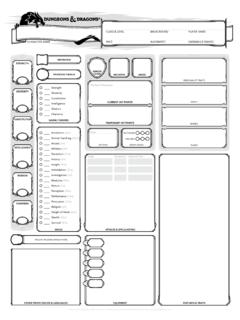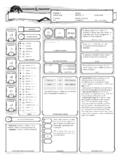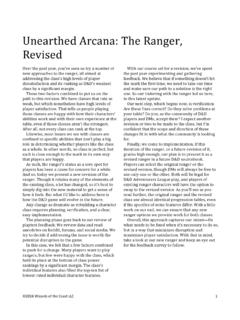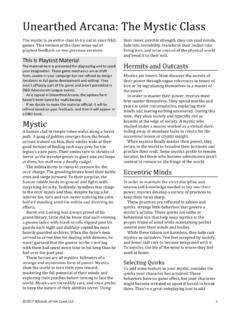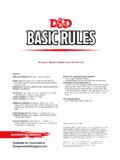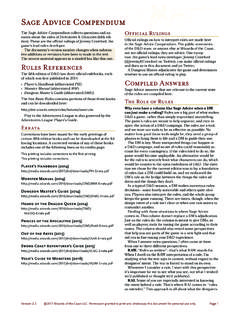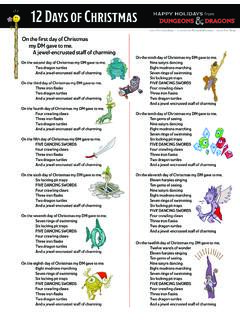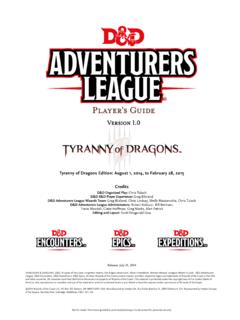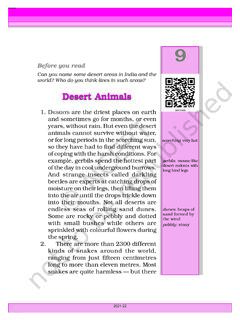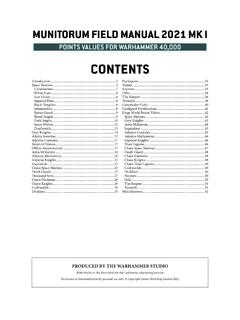Transcription of AGE 12 STARTER SET RULEBOOK - Wizards
1 Chapter 1: How to Play ..2 Getting Started ..3 Six Abilities ..4 Chapter 2: Combat ..8 The Order of Combat ..9 Movement and Position ..10 Actions in Combat ..10 Making an Attack ..11 Cover ..12 Damage and Healing ..12 Chapter 3: Adventuring ..14 Travel ..15 Resting ..15 Rewards ..15 Equipment ..16 Chapter 4: Spellcasting ..20 What Is a Spell? ..21 Casting a Spell ..21 Spell Spells ..24 Appendix: Conditions ..32 STARTER SET RULEBOOKAGE 12+Chapter 1: How to Playhe Dungeons & Dragons roleplaying game is about storytelling in worlds of swords and sorcery.
2 Like games of make-believe, D&D is driven by imagination. It s about picturing a crumbling castle in a darkening forest and imagining how a fantasy adventurer might react to the challenges that scene presents. In this fantasy world, the possibilities are 1: How to Play Dungeon Master (DM): The castle stands among the trees, the crumbling ruins of seven round towers jutting up from it like broken teeth. An archway littered with twisted shards of rusted metal gapes open at the top of a short flight of steps. Two of the towers, speckled with dark arrow slits, loom beside the entryway, and a dark hall yawns beyond.
3 Phillip (cleric): Let s send the rogue up ahead to look in and make sure it s safe. Amy (rogue): OK, I ll move to the side and sneak along the wall of the tower until I can peer in through the a game of make-believe, D&D gives structure to the stories a way of determining the consequences of the adventurers actions. Players roll dice to determine whether their attacks hit or miss and whether their characters can scale a cliff, roll away from the strike of a magical lightning bolt , or pull off some other dangerous task. Anything is possible, but the dice make some things more probable than others.
4 DM: All right, Amy, let s see how sneaky you are. Make a Dexterity check. Amy: With my Stealth skill, right? DM: You bet. Amy (rolling a d20): I m pretty sneaky that s a 17. DM: OK, there s no sign that anyone notices you. And you re looking inside?When you play D&D, you take on the role of an adventurer: a skilled fighter, a devout cleric, a deadly rogue, or a spellcasting wizard. (The character sheets included in this set describe five heroes to get you started.) With some friends and a little imagination, you strike out on grand quests and daring adventures, testing yourself against an array of challenges and bloodthirsty player takes on the role of the Dungeon Master, the game s lead storyteller and referee.
5 The DM is in charge of the adventure, which appears in the adventure book, while the characters navigate the adventure s hazards and decide where to explore. The DM might describe the entrance to Cragmaw Castle, and the players decide what they want their adventurers to do. Will they boldly stride up to the fallen gate, or try to sneak up in case anyone s watching through those arrow slits? Circle around the castle looking for another entrance? Or cast a spell to cloak themselves in invisibility?The DM determines the results of the adventurers actions and narrates what the characters experience.
6 Because the DM can improvise to react to anything the players attempt, D&D is infinitely flexible, and each adventure can be exciting and s no winning and losing in D&D at least not the way those terms are usually understood. Together, the DM and the players create a story of bold adventurers who confront deadly perils. Sometimes an adventurer might come to a grisly end, torn apart by ferocious monsters or done in by a nefarious villain. Even so, the other adventurers can search for powerful magic to revive their fallen comrade, or the player might choose to play a new character.
7 The group might fail to complete an adventure successfully, but if the players had a good time and created a memorable story, they all ting StartedIf this is your first time playing Dungeons & Dragons, start by reading the rest of this chapter. It tells you the most important rules you need to play the game. Someone needs to be the Dungeon Master for your first play experience. Since you re reading this, you re a good candidate to be the DM. (If one of your friends knows how to play D&D already, you might want to ask that person to be the DM and help you learn the game.)
8 Once you ve read this chapter, take a look at the first few pages of the adventure book. That will help you understand the role of the DM and the basics of a D&D adventure. From there, look over the rest of this book. You don t need to memorize everything before your first game, but it helps if you know where to find the rules while you play. Then get familiar with the adventure, and you ll be ready to gather your friends together to play. Each player chooses one character from the five options included. It s up to the players to turn these bare-bones characters into people by giving them names, describing their appearance, and bringing them to life while playing through the adventure.
9 If you have more than five players, it s OK for two players to use the same character, as long as they make the details of the character distinct; one cleric might be a jolly woman named Sefris, while the other is a severe man named DiceThe game uses the polyhedral dice that come with this set. In these rules, the different dice are referred to by the letter d followed by the number of sides: d4, d6, d8, d10 (the 0 on the die represents a 10), d12, and d20. For instance, a d6 is a six-sided die. Percentile dice, or d100, work a little differently.
10 You generate a number between 1 and 100 by rolling the ten-sided die twice. The first roll gives the tens digit, and the second gives the ones digit. If you roll a 7 and a 1, for example, the number rolled is 71. Two 0s represent 100. When you need to roll dice, the rules tell you how many dice to roll of a certain type, as well as what modifiers to apply. For example, 3d8 + 5 means you roll three eight-sided dice, add them together, and add 5 to the 1: How to PlayThe Structure of PlayThe D&D game consists of a group of characters (controlled by the players) embarking on an adventure that the DM presents.
